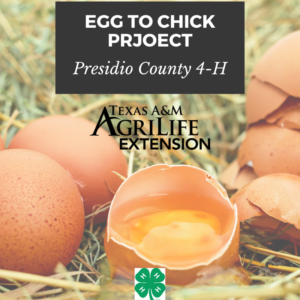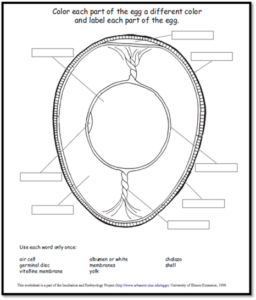
The Egg To Chick Project
Join the county extension agent for Presidio County as we cover the Egg-To-Chick Project virtually.
Presidio County 4-H YouTube Page:
The Goal
This project is designed to help youth understand the process from egg to chick with emphasis on each developmental stage. In addition to this, the goal is to help youth understand the importance of chicken and how this animal impacts our lives on a daily basis.
What is an Egg?
Well an egg is how some animals reproduce. For instance when you have a rooster (a male chicken) and a hen (a female chicken) you can get an egg that is fertilized. That means that a baby chick should come out of an egg in 21 days. For now it is called an embryo. The egg acts as its home and gives it all the nutrients and safety that it needs. This is similar to how a parent would feed you and protect you.
Can You Draw an Egg?
In the box to the left, draw your favorite egg and the animal that would live inside it.
Parts of the Egg
Can you label the parts of the egg?
The Shell:
-
The shell of the egg is the most outer part of the egg. This helps protect the egg from getting hurt.
-
Another important part of the shell is that it has small pores or tiny little holes all over it. Next time you hold an egg you can feel that it is not completely smooth and has a bumpy texture to it. The tiny holes are so that air can pass through the egg.
The Membrane:
-
The membrane of the egg is the very next layer right under the shell. This layer helps protect the egg from bacteria that can make the egg sick. This is like how your skin helps protect you.
The Air Cell:
-
The air cell is the space at the top of the egg. This space is so that when the egg cools down and heats up the insides of the egg won’t crack the shell. Just think of if you have ever seen a can of soda that has been frozen it can pop the can and overflow.
The Albumen:
-
The albumen or white of the egg is the part of the egg that is right under the shell and membrane. This part of the egg is low in fat but high in other nutrients. If you have ever seen a hard boiled egg it is the white part that you see once the shell is off the egg.
The Chalazae:
-
The chalazae is the part of the egg that looks like a rope. There is one on both sides of the egg to hold the yolk or center part of the egg in place.
The Vitelline Membrane:
-
The vitelline membrane is a clear case that keeps the yolk together.
The Yolk:
-
The yolk is the center part of the egg or the yellow part whenever you crack an egg or look at a hardboiled egg. The yolk of the egg has most of the vitamins and minerals of the egg.
The Germinal Disc:
-
The germinal disc is the spot on the side of the yolk. This is the spot where you can tell if the egg is fertilized. This is also where the chick will start to grow if the egg is fertilized.
Stages of Development
Day 1: You can see the start of the development but it just looks like a small white spot
Day 3: The heat beats for the first time and the blood vessels are very visible
Day 6: Today the beak appears and the chick can start to move a little bit
Day 13: Their scales start to appear and their body is lightly covered with feathers
Day 16: Today their feathers cover their complete body
Day 19: The remainder of the yolk is moved into the chicks body and the chick takes up most of the space inside the egg.
What is an Incubator?
The incubator is a machine that takes the place of a mother hen. The machine makes sure to keep the temperature and humidity at a perfect level so that the eggs can grow. The incubator warms the eggs and is controlled by a thermostat. The thermometer measures the temperature and tells the thermostat. The thermostat then sends a message to the heat coil to do the actual heating.
Whenever the eggs are in the incubator they must be turned three times a day so one side of the egg doesn’t get warmer than the other side. Some incubators will automatically be turning the eggs and others you have to manually turn the eggs. All of this ensures that your embryos or unborn baby chicks will have the best possible hatch rate.
What Eggs Do We Eat?
You may look at the eggs in your classroom and think how can I ever eat an egg again? You don’t have to worry because the eggs we eat are unfertilized. They are eggs that the hen lays when there is not a rooster around. Hens lay around one egg a day after they are about 6 months old. A hen can lay over 250 eggs in just one year! They will continue that process for 5 to 7 years. That’s a whole lot of eggs!


